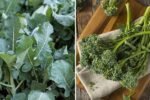If you’re looking to add bold flavor and serious nutrition to your meals, mustard microgreens are your new best friend. These vibrant, peppery greens pack a punch — both in taste and in health benefits. Loved for their distinctive spicy flavor, they’re quickly becoming a favorite among home gardeners, chefs, and health enthusiasts across the United States.
Whether sprinkled on sandwiches, tossed into salads, or blended into smoothies, mustard microgreens bring a burst of freshness and zest to every bite. Even better? They’re incredibly easy to grow right on your kitchen counter — no backyard or green thumb required!
In this comprehensive guide, we’ll cover everything you need to know about mustard microgreens: their nutritional benefits, how to grow them at home, and delicious ways to enjoy them in your daily diet.
What Are Mustard Microgreens?

Mustard microgreens are the young, tender shoots of the mustard plant (Brassica juncea), harvested just 7–10 days after sprouting. At this early stage, the greens are packed with flavor — offering a tangy, spicy kick similar to wasabi or horseradish — and are loaded with nutrients.
You’ll find mustard microgreens in several colorful varieties, including:
- Green mustard – mild and peppery
- Red or purple mustard – vibrant color and stronger bite
- Mizuna and Osaka mustard – slightly sweet with a tangy twist
Because they grow fast and require little space, mustard microgreens are perfect for urban gardeners and American households looking to eat healthier, fresher, and more sustainably.
Nutritional Powerhouse: Why Mustard Microgreens Deserve a Spot on Your Plate
These little greens may be small, but their nutrient density is off the charts. Studies show that microgreens can contain 4–40 times more nutrients than mature plants.
Here’s what makes mustard microgreens stand out:
1. Packed with Vitamins and Minerals
Mustard microgreens are rich in vitamins A, C, E, and K, along with calcium, potassium, iron, and magnesium. These nutrients support strong immunity, glowing skin, and healthy bones.
2. High in Antioxidants
They contain powerful antioxidants like beta-carotene and lutein, which protect your cells from free radical damage and help reduce inflammation.
3. Supports Heart and Digestive Health
Thanks to their natural compounds like glucosinolates, mustard microgreens may help lower cholesterol levels and support gut health.
4. Boosts Immunity and Detoxification
The spicy compounds that give mustard its kick — such as allyl isothiocyanate — also help detoxify the liver and strengthen immune defenses.
5. Great for Weight Loss and Energy
Low in calories but high in nutrients, these greens keep you energized and satisfied without adding extra weight — a perfect fit for busy, health-conscious Americans.
How to Grow Mustard Microgreens at Home

One of the best things about mustard microgreens is how fast and easy they are to grow. Whether you have a sunny window or a small grow light, you can enjoy fresh greens in less than two weeks.
What You’ll Need:
- Mustard seeds (yellow, brown, or red)
- Shallow tray or container (with drainage holes)
- Organic potting soil or coco coir
- Spray bottle or watering can
- Sunlight or LED grow light
Step-by-Step Growing Guide
1. Prepare the Seeds
No need to soak mustard seeds — they germinate quickly. Just make sure they’re clean and labeled for microgreen growing (no treated seeds).
2. Fill the Tray
Add about 1.5–2 inches of moist soil or coco coir to your tray. Gently press the surface flat.
3. Sow the Seeds
Sprinkle the mustard seeds evenly across the soil. You can scatter them densely since microgreens don’t need much room.
4. Mist and Cover
Use a spray bottle to mist the seeds with water, then cover the tray with a lid or another tray to block light. Keep them in a dark, warm spot (around 70°F) for 2–3 days.
5. Light Exposure
When the seeds sprout, remove the cover and place the tray near a sunny window or under a grow light. Mustard microgreens love bright light — it helps them develop that vibrant green or purple hue.
6. Water Regularly
Mist daily to keep the soil moist but not waterlogged. Overwatering can cause mold, so aim for a balance.
7. Harvest Time!
Your mustard microgreens will be ready to harvest when they’re 2–3 inches tall, usually around 7–10 days after planting. Use clean scissors to snip them just above the soil line.
8. Rinse and Store
Rinse your freshly cut greens gently, dry them, and store them in an airtight container in the fridge. They’ll stay crisp and flavorful for up to a week.
Mustard Microgreen Varieties to Try

There are several exciting mustard varieties to grow, each with its own flavor and look:
| Variety | Flavor Profile | Color | Spice Level |
|---|---|---|---|
| Yellow Mustard | Mild and tangy | Bright green | Low |
| Red Giant Mustard | Peppery, bold | Deep red-purple | Medium-High |
| Osaka Purple | Sweet and spicy | Dark green with purple veins | High |
| Mizuna | Light, fresh | Green | Mild |
Each variety offers a slightly different taste experience, making mustard microgreens a fun crop to experiment with.
Delicious Ways to Enjoy Mustard Microgreens

These zesty greens are as versatile as they are nutritious. Here are some delicious ways to use mustard microgreens in everyday meals:
1. Brighten Up Salads
Add a handful of mustard microgreens to your salads for a tangy, peppery flavor. They pair beautifully with avocado, roasted nuts, and citrus dressings.
2. Layer on Sandwiches and Burgers
Swap out lettuce for mustard microgreens to give your sandwiches or burgers a gourmet, spicy edge. They add a satisfying crunch and a pop of freshness.
3. Top Your Eggs or Avocado Toast
Sprinkle microgreens over scrambled eggs, omelets, or avocado toast for a colorful, nutrient-rich breakfast.
4. Blend into Smoothies or Juices
Add a handful to your green smoothie for a subtle spicy boost that complements fruit and leafy greens.
5. Mix into Pasta or Grain Bowls
Toss them into pasta, quinoa, or rice bowls just before serving. The residual heat will lightly wilt the greens and mellow their spice.
6. Use as a Garnish
Top soups, tacos, or roasted vegetables with mustard microgreens to add vibrant color and flavor.
Tips for Perfect Mustard Microgreens

Even though mustard microgreens are easy to grow, these tips will ensure the best results:
- Use quality seeds: Always choose seeds labeled for sprouting or microgreens.
- Avoid overwatering: Too much moisture encourages mold.
- Ensure air circulation: A small fan nearby can prevent dampness.
- Rotate the tray: Turn it daily for even light exposure.
- Harvest early: For the best flavor, harvest when the first true leaves appear.
Common Growing Problems and Solutions
| Problem | Cause | Solution |
|---|---|---|
| Mold or fungus | Excess moisture, poor ventilation | Water less and increase airflow |
| Yellow leaves | Lack of light | Move tray to a sunnier spot |
| Bitter taste | Late harvest | Harvest earlier, around 7–10 days |
| Uneven growth | Overcrowded seeds | Space seeds evenly across the tray |
Why Mustard Microgreens Are Perfect for American Homes
With the growing demand for homegrown, organic, and sustainable food, mustard microgreens fit perfectly into the modern American lifestyle.
- Eco-friendly: Grown locally — zero transport, zero packaging waste.
- Space-saving: Perfect for apartments or small kitchens.
- Fast-growing: Harvest-ready in under two weeks.
- Budget-friendly: A handful of seeds can yield several trays.
- Healthy eating made simple: Fresh greens whenever you want them.
Whether you’re living in a high-rise in New York or a farmhouse in Texas, growing your own mustard microgreens means fresher food, better nutrition, and a more sustainable way to eat.
Conclusion: Spice Up Your Life with Mustard Microgreens
Mustard microgreens bring more than flavor — they bring life, color, and vitality to your kitchen. With their signature spicy taste, vibrant hues, and incredible nutrient content, they’re the perfect microgreen for anyone looking to take their health and home gardening to the next level.
Easy to grow, quick to harvest, and endlessly versatile, mustard microgreens embody everything Americans love about homegrown food — convenience, sustainability, and great taste.
So grab some seeds, plant your tray, and get ready to add a little spice to your life. Because with mustard microgreens, every meal becomes a fresh, flavorful celebration of health and homegrown goodness.





